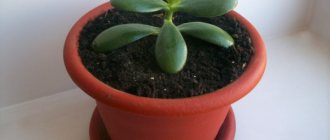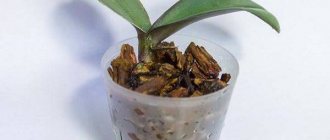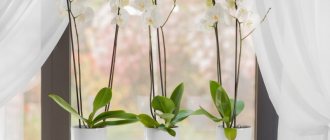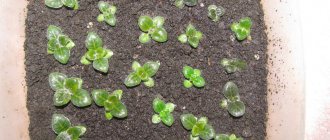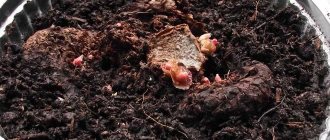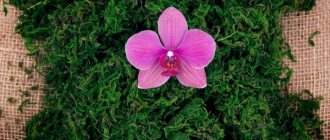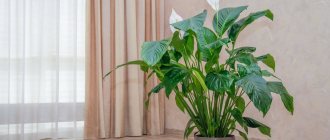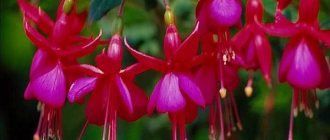Pots for orchids can be made from various materials, but the main requirements that orchids place on them are: good water permeability and the inability of roots to grow to the walls of the pot. Orchid growers also want the pot to look aesthetically pleasing.
A simple cut-off drinking water bottle with holes cut with a knife will satisfy the orchid. But it’s not pretty, but I want to show off the flower. Therefore, orchid owners are looking for other options, although even from a bottle you can make a beautiful pot if you use your imagination.
Which orchid pot is better to choose?
When choosing a pot for phalaenopsis, you should start from the physiological characteristics of the plant. Under natural conditions, exotic butterflies grow epiphytically, without a pot or substrate. Their root system wraps around tree trunks and rock ledges. Therefore, a flowerpot is needed as a container for the substrate in order to create stability for the plant and direct growth in the right direction.
What to look for when choosing
For an orchid, you must choose a bowl that meets the following requirements:
- the container must allow air to pass through;
- the height of the vessel should be equal to the width of the neck;
- high light transmission;
- sufficient volume.
Most types of orchids cannot develop normally in darkened containers - the roots need light.
Root Safety
The size of the flowerpot for epiphytic plants should correspond to the size of the root system. You should not choose an empty container. When replanting, you should choose a container that is 1 cm larger in diameter than the previous one.
Necessary moisture drainage
The roots of the flower do not like waterlogging - it may die. Therefore, special flowerpots are sold for orchids, the bottom of which looks like a sieve. It is advisable that the drainage holes are located not only at the bottom, but also on the sides of the container.
Temperature
The root system is involved in photosynthesis - it receives all the useful substances from air and light for the development of the epiphyte.
The importance of making the right choice
In order for the orchid to feel as comfortable as possible in the apartment, it will need to recreate living conditions that correspond to natural ones. This is relatively easy to do, because phalaenopsis is able to quickly adapt to life in the house.
The potty greatly speeds up the acclimatization process. It should be selected depending on the size of the root part of the crop. There is no need to buy a particularly spacious one - it is enough that the new container is only 20 or 30 millimeters wider than the previous one.
In the shelter, the flower should receive exactly as much water and air as it requires. Regulation of both parameters occurs due to drainage holes. The latter are present not only at the bottom of the vessel, but also on its walls.
In addition to the roots themselves, the pot must also contain a certain volume of substrate. It serves as a support for the flower and provides storage of a strategic supply of moisture and nutrients.
It is worth considering that systematic drying out of the soil, as well as its excessive wetting, harm phalaenopsis. The first danger lies in wait for an orchid placed in a cramped pot, and the second - in one that is too voluminous.
Another circumstance that should not be forgotten is that the roots of a flower participate in such an important process for its health and development as photosynthesis. This means, in particular, that they, just like the above-ground parts, need light. The access of the latter is organized due to the transparency of the walls.
What materials are they made of?
In a specialized store you can buy plastic, clay, ceramic, glass, and bamboo pots.
Plastic
The most common option. Some of the advantages include:
- transparent material does not interfere with photosynthesis;
- provides a good overview, you can monitor the condition of the roots;
- additional drainage holes can be easily made;
- The roots of the plant are always warm and do not grow to the material.
The plastic container ensures a stable temperature regime, preventing the roots from overheating or overcooling.
The only drawback is the lightness. Tall flowers may tip the plastic over, so it is recommended to add extra weight. To give it an aesthetic appearance, a plastic container can be placed in a beautiful ceramic pot. You can grow dendrobiums, cambrias, phalaenopsis, and some types of vandas in them.
Glass
A clear container will not interfere with photosynthesis, but it does require growing experience. The glass container does not have drainage holes, so it is important to watch not to overwater.
For multiple plants (double)
Double is designed for planting two phalaenopsis. Many novice gardeners confuse such a container with a plant pot that connects the container itself with a flowerpot (with a double bottom).
Such containers are aesthetically pleasing from the point of view of interior decoration. But when choosing, it is not always possible to guess what size will be needed for two plants.
Ceramic and clay
Growing epiphytic plants in a ceramic or clay pot has many advantages:
- the porous structure does not interfere with the flow of air to the root system;
- the material is heavy, which gives stability;
- prevents roots from getting too cold;
- fits well into interior design.
But the materials have their drawbacks. The fact is that orchid roots easily grow to the porous structure of the walls, so many of them are damaged during transplantation.
In addition, salts clog pores, which negatively affects air exchange and does not allow excess moisture to evaporate.
Flowerpots
Having bought a flowerpot for orchids, you can be sure of its stability - the flower will not fall, stain the furniture, or break. The size of the pot should be larger than the pot itself. It is advisable that you can stick your finger between the wall of the pot and the container. It is recommended to hang orchids near a window so that the root system receives the necessary amount of light.
It is wrong to think that a sufficient number of drainage holes will prevent stagnation of water. Water may accumulate at the bottom of the pot. To prevent root rotting, charcoal, perlite or broken shards should be poured onto the bottom. It is recommended to make the drainage layer 8 cm high.
The crown is an ideal pot for orchids. It is designed in such a way that a constant flow of air is provided to the roots of epiphytic plants. This is facilitated by the gaps located between the rods.
Made from bamboo
In the manufacture of containers for orchids, materials such as coconut, bamboo, willow, and rattan are used.
Advantages of flowerpots made from natural materials:
- good air exchange protects the roots from overheating and waterlogging;
- natural materials create an environment close to natural.
To reduce moisture evaporation, it is necessary to cover the top of the substrate with sphagnum moss.
Flaws:
- The root system easily grows to the walls of wicker pots. It is better to choose a smooth container, for example, made of bamboo.
- In natural flowerpots, the substrate dries out very quickly, so frequent watering is required using the immersion method.
- The soil spills out through the cracks and is washed out.
To preserve the substrate in a flowerpot, you need to cover the bottom of the container with burlap and lay down moss or bark.
Clay and ceramic pots
Soil for Dracaena - which one is needed and how to choose
Unlike plastic, ceramic and clay containers for orchids look very prestigious and will highlight the beauty of the flower. Their weight will eliminate the risk of knocking over the pot with the plant.
Important! Ceramics and clay create excellent drainage and ventilation conditions: these materials contain many pores.
However, root hairs of orchids easily grow into the pores, so you should only take glazed pots, they are smooth. Over time, numerous waterings fill the pores with salts. In such a container, the orchid begins to hurt.
Clay and ceramic pots do not offer the transparency that most orchids require.
Design features of pots
To make caring for orchids easier, newfangled models and devices have been created.
Self-watering pot
The purchase of such a design is justified in the case of growing several orchids. A huge plus is saving time.
A flowerpot with automatic watering and phyto-lighting comes to the aid of busy people. You can safely go on vacation or a business trip and not worry that green pets will suffer from a lack of moisture and light.
Hanging models
The main advantage is stability; it will never tip over from the weight of the plant. It is recommended to purchase a hanging model if there is a mischievous kitten or small children in the house.
The best location for a flower is close to an east or west window. In this case, the orchid will receive enough light.
Miniature varieties are often grown in hanging pots. In order not to be afraid that moisture will accumulate at the bottom, you can pour a drainage layer of perlite, charcoal, in a layer of 8 cm.
Crown
Orchids look interesting in such a needle-shaped container. Compared to a plastic pot, the crown fits well into the interior. Good enough for growing flowers. Watering the orchids is done through the tray that comes with the kit.
To prevent soil from falling out of the cracks and creating an unpleasant sight, the size of the fractions should be slightly larger than the inter-needle space.
With phyto lighting
This design is convenient in conditions of lack of natural light. The backlit model ensures normal development of plants in autumn and winter. It can be used as a night light. The only negative is the high cost.
Does pot size matter?
The selection of containers for planting orchids is selected in accordance with the size of the root system. The height of the plant and the number of leaf blades do not play any role in this. If the flower is very tall, additionally buy flower pots to give it stability.
The orchid is transplanted into a flowerpot whose diameter is slightly larger than the previous container. If you transplant into a container that is too empty, there is a high probability of root rotting. In addition, there will be no flowering until the roots completely fill the space provided to them.
Do you need holes in an orchid pot?
A prerequisite for the normal development of epiphytic butterflies is the presence of drainage holes in the bottom. This is due to the physiological characteristics and characteristics of the root system - excess moisture should evaporate and the roots should be well ventilated. Without a sufficient number of holes, such results cannot be achieved.
How to make a hole in an orchid pot
Lots of holes are needed at the bottom of the container. Air exchange occurs through them and excess moisture evaporates. Therefore, it is recommended to drill a lot of holes even in a glass container. This can be done using special tools.
Glass flowerpots
Of course, looking at various photos of a glass orchid pot, everyone wants to recreate the same beauty at home. A flower in such a container will look very elegant. But choosing a flowerpot that meets the above requirements is somewhat problematic.
This primarily applies to drainage holes in glass products. An orchid that is sensitive to various unfavorable conditions is not able to withstand waterlogging, and draining unnecessary liquid without disturbing the plant is not an easy task.
In this case, you can do this:
- The flower is planted in a plastic container.
- All this is placed in a glass flowerpot.
- The plastic is hidden by a layer of drainage.
- If necessary, the plastic container is lifted from the flowerpot, water is poured out of it, and then everything is returned to its place.
This is the easiest way to transplant an orchid into a plastic pot and then into a flowerpot.
How to choose a pot to match your interior, photo
The stores offer a wide selection of flowerpots and pots for orchids - floor-standing, plastic, hanging, wicker, wooden, clay, ceramic. When choosing, you must adhere to the following rules:
- stylistic combination – figured flower pots can decorate a child’s room; for a hall or living room, it is recommended to choose a simple model with strict lines;
- neutral color will be appropriate in any room;
- if several orchids will be located in one room, all flowerpots should be from the same collection.
Flower growers with design skills can easily select the right combination of shapes and styles.
Which pots should you not choose?
If the size of the pot and the root system do not match, phalaenopsis may stop flowering and get sick.
Pots not suitable for epiphytes:
- the inner surface of an unfired ceramic pot has roughness, which promotes root germination;
- It is very difficult to maintain aeration in glass pots;
- the elongated container does not provide sufficient air and moisture exchange.
As a result of improper maintenance, the root system rots, plants lag behind in growth, and flowering stops.
Conditions for growing phalaenopsis
In order to grow this beautiful flower in artificial conditions, it is necessary to create conditions similar to natural ones:
- clean air with high humidity;
- a well-chosen vessel;
- use of a special substrate;
- no dust;
- growing on eastern and western windowsills.
After purchasing a phalaenopsis seedling, caring for the plant consists of maintaining the required temperature, room humidity and watering. Beginning gardeners who are eager to grow this flower are tormented mainly by 2 questions: is it possible to plant an orchid in an opaque pot and is it necessary to plant an orchid in a transparent pot?
The answer here is ambiguous. It is advisable to plant the orchid in a transparent pot, but if this is not possible, you can use an opaque one, but with side holes to saturate the roots with oxygen. Through the transparent walls of the vessel, the owner observes the condition of the plant's root system. 2 years after planting, the grown flower is transplanted into a selected vessel for permanent cultivation. In order not to be tormented by doubts about how to choose the right pot for orchids, you need to know the characteristics of the plant.
Pots for phalaenopsis and babies
Mini-phalaenopsis prefers to grow in conditions of high humidity, so this type of orchid should grow in mini glass pots. The moisture in them lasts for a long time, the roots are quite comfortable in a small container.
Before transplantation, the children grow in a transparent small pot, which is:
- disposable plastic cup;
- a transparent yogurt cup;
- plastic jar for cotton swabs.
Substrate for phalaenopsis
Regular soil is not needed to cultivate this plant. It is better to grow the plant in a prepared mixture, which should be:
- breathable;
- light;
- loose;
- moisture-intensive.
As a nutrient substrate, select:
- sphagnum moss;
- pine and oak bark;
- charcoal;
- peat;
- expanded clay;
- vermiculite;
- coconut fiber;
- Pine cones.
How to make it yourself, video
Designers have created original pots for orchids. Every gardener can make a container with his own hands from available materials - plastic containers or food baskets.
The main condition is drainage holes. Many people like coconut shell pots. But such structures are not suitable for orchids, since the roots grow into the porous structure and can be damaged during the next transplantation.
Some types of orchids cannot grow in wicker baskets. The fact is that in such pots the moisture evaporates very quickly, the rods themselves crack and become unsightly.
The video shows how to make an orchid pot with your own hands.
When growing orchids, it is necessary to adhere to agricultural techniques. To ensure good development, lush and abundant flowering, you need not only to choose the right location and provide watering, but also to choose the right pot. A suitable container is the key to the health of orchids.
Orchids for interior design
The most common type of home orchids you see in the photo above. A plant with one or two long stems without leaves. Each stem bears a cluster of white, pale pink, pale lilac, hot pink, cyclamen flowers, and long leaves at the very base. It is this elongated, fragile, sophisticated shape that has made it a favorite of designers.
Such an orchid can be a single flower in a pot that produces only one or two flower stems:
Or you can plant several of these plants in one large pot, and they will give a more magnificent picture:
Compare two pictures:
A single branch looks very delicate and fragile, it is perfect for an interior with vintage, romantic, Japanese motifs - for all elegant, restrained, feminine interiors.
The home orchid is an excellent flower for the bedroom, especially if the bedroom is designed in an elegant, flirty and even glamorous spirit:
Of course, this does not mean that it looks good only in such interiors as in the photo above. The flower fits perfectly into modern interiors.
For which interiors is it not suitable?
In general, in my opinion, the orchid is not suitable only for rough styles, such as country, rustic, all variants of eco-style, pop art, punk, etc. At the same time, in deliberately brutal styles, such as loft, industrial or hi-tech, it can look very good precisely due to the contrast of a delicate flower and a rough background.
As you can see, here, against the backdrop of a modern interpretation of the rustic style, the orchid looks rather alien. Well, at least in my opinion


